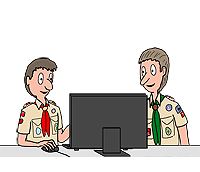
ATOMIC ENERGY
This Merit Badge was completely rewritten and
the name changed to NUCLEAR SCIENCE IN 2005
These were the REQUIREMENTS before the REVISIONS
made on January 1, 2005.
To see the current requirements
Click Here
- Tell the meaning of the following: alpha particle, atom,
background radiation, beta particle, curie, fall- out, half-life,
ionization, isotope, neutron, neutron activation, nuclear energy,
nuclear reactor, particle accelerator, radiation, radioactivity,
Roentgen, and x ray.
- Make three-dimensional models of the atoms of the three
isotopes of hydrogen. Show neutrons, protons, and electrons.
Use these models to explain the difference between atomic weight
and number.
- Make a drawing showing how nuclear fission happens. Label
all details. Draw a second picture showing how a chain reaction
could be started. Also show how it could be stopped. Show what
is meant by a "critical mass."
- Tell who five of the following people were. Explain what
each of the five discovered in the field of atomic energy: Henri
Becquerel, Niels Bohr, Marie Curie, Albert Einstein, Enrico
Fermi, Otto Hahn, Ernest Lawrence, Lise Meitner, William Roentgen,
and Sir Ernest Rutherford. Explain how any one person's discovery
was related to one other person's work.
- Draw and color the radiation hazard symbol. Explain where
it should and should not be used. Tell why and how people must
use radiation or radioactive materials carefully.
- Do any THREE of the following:
- Build an electroscope. Show how it works. Put a radiation
source inside it. Explain any difference seen.
- Make a simple Geiger counter. Tell the parts. Tell which
types of radiation the counter can spot. Tell how many counts
per minute of what radiation you have found in your home.
- Build a model of a reactor. Show the fuel, the control
rods, the shielding, the moderator, and any cooling material.
Explain how a reactor could be used to change nuclear into
electrical energy or make things radioactive.
- Use a Geiger counter and a radiation source. Show how
the counts per minute change as the source gets closer.
Put three different kinds of material between the source
and the detector. Explain any differences in the counts
per minute. Tell which is the best to shield people from
radiation and why.
- Use fast-speed film and a radiation source. Show the
principles of autoradiography and radiography. Explain what
happened to the films. Tell how someone could use this in
medicine, research, or industry.
- Using a Geiger counter (that you have built or borrowed),
find a radiation source that has been hidden under a covering.
Find it in a least three other places under the cover. Explain
how someone could use this in medicine, research, agriculture,
or industry.
- Visit a place where X ray is used. Draw a floor plan
of the room in which it is used. Show where the unit, the
person who runs it, and the patient would be when it is
used. Describe the radiation dangers from x ray.
- Make a cloud chamber. Show how it can be used to see
the tracks caused by radiation. Explain what is happening.
- Visit a place where radioisotopes are being used. Explain
by drawing how and why it is used.
- Get samples of irradiated seeds. Plant them. Plant a
group of nonirradiated seeds of the same kind. Grow both
groups. List any differences. Discuss what irradiation does
to seeds.
BSA Advancement ID#: 24
Pamphlet Revision Date: 1983
Requirements last updated prior to 1982
|





